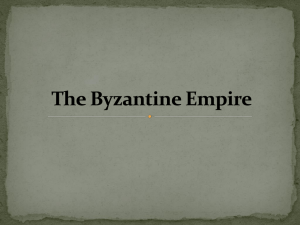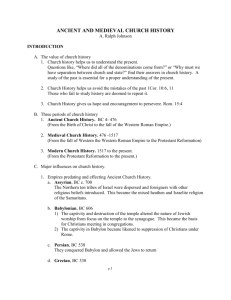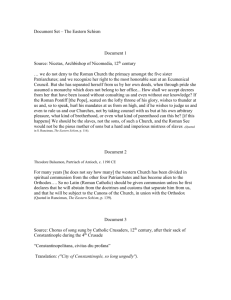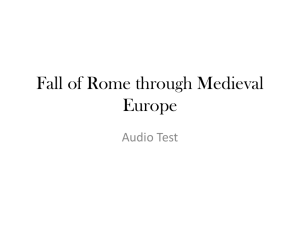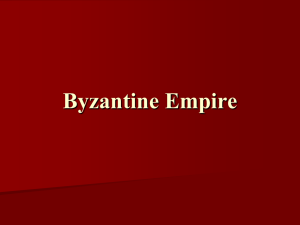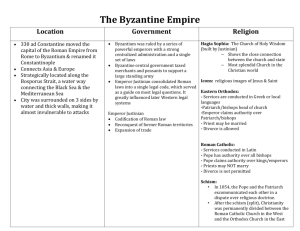Document
advertisement
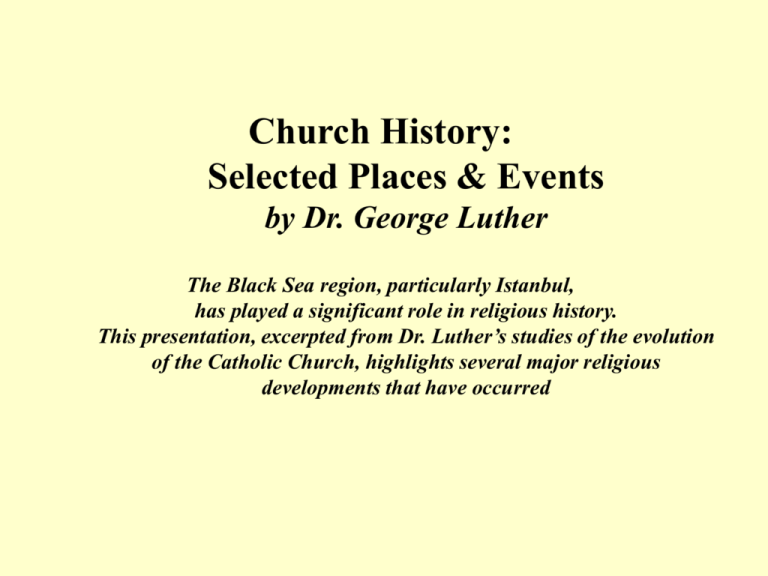
Church History: Selected Places & Events by Dr. George Luther The Black Sea region, particularly Istanbul, has played a significant role in religious history. This presentation, excerpted from Dr. Luther’s studies of the evolution of the Catholic Church, highlights several major religious developments that have occurred Journeys of St. Paul One of the most important figures in early Christianity, Saint Paul made extensive journeys as a Christian missionary throughout the eastern Mediterranean. Paul’s goal, to reach peoples still untouched by the work of evangelists, proved to be a strenuous and often difficult task. He survived three separate journeys during the A.D. 40s and 50s, bringing Christianity to Macedonia and Greece. During a fourth trip, however, the Romans arrested Paul in Jerusalem and probably executed him in Rome in A.D. 62. Entering Ephesus as St. Paul might have Library at Ephesus Theater at Ephesus seating capacity of 25,000 people Population of 250,000 in Ephesus at the time of St. Paul Leaving Ephesus: Remnant of the Temple to Artemis — one of the seven wonders of the ancient world Basilica of St. John the Apostle at Ephesus Burial place of St. John entrance Constantine — from persecution to acceptance Constantine created a favorable environment for Catholics after his victory over Maxentius in 312. He had a vision of Christ before battle and his soldiers used Christ’s monogram on their shields (chi and rho). This led to the unification of church and state interests (which is not always a good thing in history). The Catholic Church did not really show tolerance of other religions until Vatican II in the 1960s. Constantinople (originally named Byzantium from the Greeks) became the seat of the Eastern Roman Empire (Byzantine) and Eastern Christendom from 320 to 1453. The Pope remained in Rome. Constantinople was not overrun by barbarians (huns, etc. ) or other groups as early Rome was. It was finally taken by the Turks (Islamic faith) in 1453 and named Istanbul. This cut off the route to the East and led to the European migration to the Americas where Catholicism and Protestantism quickly spread. Constantinople – Hagia Sophia (Church) built 532–537 Constantinople – Church of Hagia Sophia (Holy Wisdom) Largest indoor structure for 1,000 years. Emperor Constantine and wife pictured with Christ Byzantine Empire The Byzantine Empire evolved from the Roman Empire’s eastern territories after the Roman Empire’s western regions fell in the 5th century. Initial harmony between the church and state fortified the early empire (4th-6th centuries). Rome could depend on some modest military support from Constantinople. The Crusades taxed the territories during the 11th century, precipitating a decline. Constantinople, the capital, fell in 1453 to the Ottoman Turks, who conquered the last remnants of the Byzantine Empire a few years later. Post Chalcedon and the Barbarian attacks - Europe Constantinople eventually lost much territory to the Muslims by the end of the 7th century. This lessened influence with Rome, which was aligning itself with the Franks (e.g., Charlemagne) to create the Holy Roman Empire and protect itself from the Byzantine Empire and the barbarians. The papal states (in Italy) were granted to the Pope by Pepin the Short in 754. The Pope began to crown emperors, but it also led to state officials bestowing staff/rings (symbols of spiritual authority) to clergy (Investiture). Clergy or prelates became secular rulers also appointed by the king. Reform of Investiture occurred late in the 11th century. Holy Roman Empire Papal states Mobile Monks/Friars St. Francis of Assisi ministers to the poor outside town walls. Great need to minister to everyone. He creates the manger scene — creche — that is used at Christmas time. Coincides with the Crusades (1095 – 1270) and the increased movement of merchants between countries and empires. Education is for the elite and is still not provided to the masses. The First Crusade In response to the announcement by Pope Urban II of a Crusade to the Holy Land in 1095, Christian forces from western Europe converged on Constantinople, where they united with Byzantine forces to attack Seljuk Turk armies in Anatolia and Muslim armies in Syria and Palestine. By 1099 the Crusaders had achieved their goal — the capture of the city of Jerusalem. However, Christian territories acquired during the First Crusade were gradually lost over the next 200 years. Jerusalem was recaptured by Muslim forces in 1187, and the last Christian stonghold in the Holy Land fell in 1291. The Crusader States In the aftermath of the First Crusade (1096–1099), Europeans carved out four states in Palestine, on the eastern coast of the Mediterranean Sea. Many castles and fortresses were built to protect the states from Muslim forces. However, the Muslims gradually recaptured the territory, and European presence in Palestine ended with the fall of the city of Acre in 1291. Constantinople Again The crusades weakened Constantinople, which fell to the Turks in 1453. In fact the crusades helped to band the Muslims together to expel the crusaders. This began the shift of the Eastern Orthodox Church’s center of power toward Ukraine/Russia. This is the Galata Tower, which overlooks the Bosporus strait and from which the Venetians watched the Turks capture Constantinople. Constantinople View from the old city north on the European side. View from the old city east to the Asian side. Great schism between rival Popes! In 1378, two rival Popes (Pope Urban VI; Clement VII) were elected. Pope Urban was elected first but was not deemed fit by many others for the position. Clement VII was elected and moved (captive) to Avignon, France, where the French king welcomed him (Church-State problems). Allegiance to a Pope was politically motivated. Conflict between Rome and Avignon lasted about 50 years and led to a call for reform in Church affairs. The problem was solved by the Council of Constance in 1414–1418. This schism sowed the seeds for reform within the Catholic Church and for the Protestant Reformation movement. Reformation “Straw that broke the camel’s back” was corruption in the Church at all levels. Lutheranism is the first protestant church, which spreads to Scandinavia. Calvin leads reform in France and Zwingli in Switzerland. Response to the Vatican/Pope selling indulgences, jobs, offices, etc. Leads to rejection of papal authority by Protestants. This had occurred in the previous century as Wycliffe in England and Hus in Bohemia spoke out against this practice. Hus was executed as a heretic in 1415. The Reformation could not have occurred without willing kings, dukes, etc., who created a new Church-state relationship (as in the Rome-Avignon schism). Aided by the invention of the printing press in 1450, information could be quickly spread to the masses. Reformation — a quest for education of religion to all not just clergy. Centers on the Bible (Scripture) rather than scripture and Church tradition. Worship is allowed in the vernacular language rather than using Latin. Henry VIII creates the Anglican Church — a personal matter that later turned to doctrinal matters. Rise of Protestantism: Europe experienced a tremendous religious revolution during the 16th century that caused a severe disintegration of the nearly absolute power wielded by the Roman Catholic church in Europe. The rise of Islam in the 7th century and the failing relations between the eastern and western Catholic churches, which led ultimately to the final schism in 1054, had already dealt Roman Catholicism a mighty blow. John Huss (Jan Hus), Peter Waldo, and John Wycliffe, preReformation activists, set the stage for the large-scale movements of the 16th-century reformers such as Martin Luther and John Calvin. Ernst Troeltsch, a German church historian, called this time the Age of Confession, in part because each new group scrutinized and thus forced confessions from the ones that preceded it. The timeline pictured here shows many of the wide array of religious groups that have arisen since Martin Luther first nailed his Ninety-Five Theses on the door of the Castle Church in Wittenberg. Protestant Europe During the 16th century, Roman Catholic Europe underwent several drastic changes as Protestant reform movements swept through the continent. The Roman Catholic church and its ruling papacy could not withstand the tremendous onslaught of reformers such as Martin Luther and John Calvin. Though the church launched a strong Counter Reformation, it never managed to regain the territory it lost during the 16th and 17th centuries. Counter Reformation #8 – Trent 1545-63 After the schism created by Luther and the protestant reform movement, the Church convened this council. Response was too late in many respects. But, the Church sought to revitalize itself and oppose Protestantism. An activist program developed that spread Christianity to the newly explored territories in the Far East and in North and South America. The key doctrines that were under attack and defined were: The need for scripture and tradition, performing good works aided by grace, the 7 sacraments, the hierarchical Church, divine institution of the priesthood, transubstantiation and the sacrificial character of the Mass. Papal supremacy was reinforced. This is the direct line to St. Peter – “on this rock, I will build my Church”. Counter Reformation #8 – Trent 1545-63 Led to a continuation of Renaissance art, architecture and music. St. Peter’s basilica was built. Erasmus and St. Thomas Moore created guidelines that should enable the lay person to achieve an individual connection with God. Theology should be open to all laity. Influenced liberal arts scholarship. The Jesuits were founded by St. Ignatius of Loyola. They ministered worldwide. Other new orders also were initiated. Significant increase in faith and good works by Catholics arose from the Council of Trent. Post Counter Reformation #8 Some problems; for example the trial of Galileo because of his assertion from Copernican theory that the earth revolved around the sun. Galileo wrote in 1614 on the irrelevance of biblical passages in scientific arguments, holding that interpretation of the Bible should be adapted to increasing knowledge and that no scientific position should ever be made an article of Roman Catholic faith. Philosophers helped in having Church theologians create the conflict by linking Galileo’s science with heresy. This created friction between science, religion and philosophy. Galileo was vindicated in 1992 by a papal commission that acknowledged the Vatican’s error of near 4 centuries ago. Much of this due to our Pope, John Paul II. First Vatican Council #9 – 1869-70 By this time, the church was not closely tied together with any state. This was true of Protestantism also. Papal states were taken over by the government of Italy, but Pope Pius IX expanded his spiritual authority over the international Church (Ultramontanism). He had already declared the “Immaculate Conception” in 1854. Doctrine of papal infallibility on matters of religion (faith and morals) was declared. Described the Pope’s role in the Church and enhanced Papal ministry, which is so important today. This Council spurred an internal spiritual renewal with many entering seminaries, convents and monasteries. This at a time when Marx, Nietzsche and others openly attacked Christianity. Hospitals and missions were founded around the world. Mass attendance and devotional life increased. Second Vatican Council #10 – 1962-65 Pope John XXIII called for an updating that would be a pastoral response to the contemporary needs of the modern world. Reaching out to other Churches/movements including Protestants and Eastern Orthodox rites. Finally the Church began to tolerate other churches and to try to reconcile past schisms. Still a long way to go because of the long history. Enhanced scientific-historical studies of the Bible which were resisted in the 19th century. Vernacular languages permitted for the celebration of the Mass! Latin usage had continued through the centuries. Advanced the dignity of human beings; liberation of humans from political and economic oppression important. Where are we now? Problems as in the recent sexual abuse of laity by priests. Pope John Paul II has been a staunch supporter of the reforms of Vatican Council II. He has made significant efforts to reconcile differences between other churches, but has been rebuffed by the Russian Orthodox Church. He and other recent Popes have been deeply religious and committed to Christ. We’ve been blessed to have so many saints to inspire us to live as Christ taught us. We also know of people in our lifetime who will likely become saints. We are still a Church where Jesus abides with us through the Holy Spirit.

